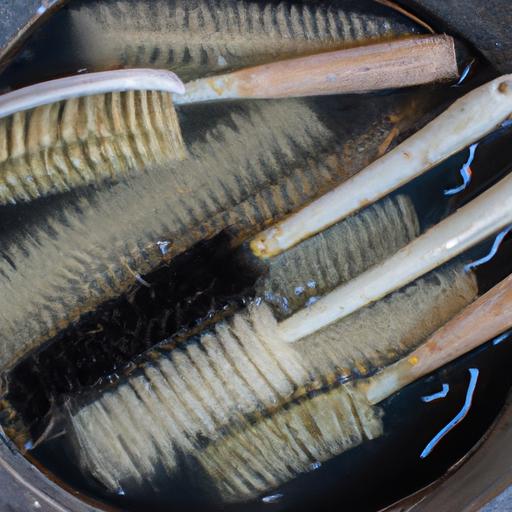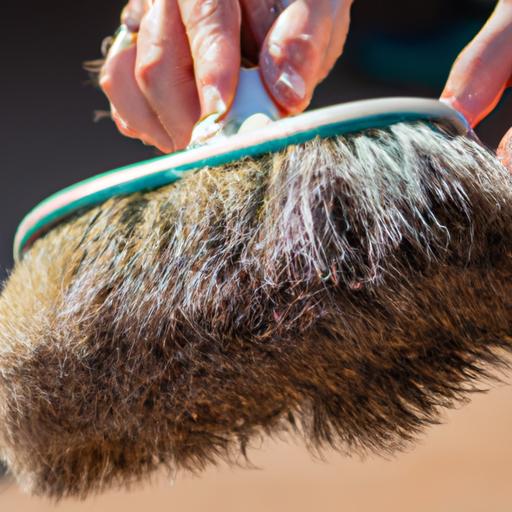Discover the best tips for cleaning horse grooming brushes. Learn about regular inspection, cleaning frequency, avoiding cross-contamination, and drying techniques.
When it comes to caring for our beloved horses, grooming plays an integral role in maintaining their health and overall well-being. Among the essential grooming tools, horse grooming brushes hold a special place. These brushes not only help in removing dirt and debris from the horse’s coat but also promote healthy circulation and a shiny, lustrous appearance. However, to ensure their effectiveness, it is crucial to keep these brushes clean and well-maintained. In this article, I will delve into the importance of cleaning horse grooming brushes and the benefits it brings to our equine companions.
A. Importance of Horse Grooming Brushes
Imagine going days without brushing your hair or washing your face. Not a pleasant thought, right? Well, the same applies to our horses. Regular grooming with brushes not only helps in keeping their coats clean and shiny but also aids in distributing natural oils, preventing matting, and improving blood circulation. Horse grooming brushes are designed to remove dirt, dust, loose hair, and even parasites, ensuring that our equine friends stay comfortable and healthy.
B. Benefits of Regular Brush Cleaning
Now that we understand the significance of horse grooming brushes, let’s shift our focus to the importance of keeping them clean. Regular brush cleaning offers a plethora of benefits for both the horse and the brush itself. Firstly, cleaning brushes removes accumulated dirt, hair, and debris, preventing them from becoming breeding grounds for bacteria and fungBy eliminating these potential sources of infection, we can protect our horses from skin irritations, allergies, and even more severe conditions.
Moreover, cleaning horse grooming brushes enhances their effectiveness. As brushes get clogged with dirt and hair, their bristles become less efficient at removing debris from the coat. By regularly cleaning and maintaining the brushes, we can ensure their optimal performance, resulting in a thorough and enjoyable grooming experience for both the horse and the groomer.
Join me in the next section as we explore the different types of brushes and the materials used in their construction. Together, we’ll uncover the secrets to keeping our horse grooming brushes in their prime condition.
Understanding the Basics of Horse Grooming Brushes

Grooming brushes come in various types, each serving a specific purpose in maintaining a horse’s coat. Understanding the different types of brushes and their uses is essential to ensure we provide our equine companions with the care they deserve.
A. Different Types of Brushes and their Uses
-
Curry Comb: This brush has rubber or plastic bristles and is used to loosen dirt, mud, and loose hair from the horse’s coat. Its circular motion stimulates blood circulation and massages the horse’s muscles.
-
Body Brush: With soft bristles, the body brush is used for removing surface dirt, dust, and loose hair. It is perfect for everyday grooming and leaves the coat with a natural shine.
-
Dandy Brush: With stiffer bristles, the dandy brush is designed to remove stubborn dirt and mud from the horse’s coat. It is ideal for use before bathing or when the horse is particularly dirty.
-
Flick Brush: This brush has long, flexible bristles and is used to remove fine dust and debris from the coat. It is an excellent final touch after using the body and dandy brushes.
-
Mane and Tail Brush: Equipped with long and widely spaced bristles, this brush helps detangle and remove debris from the horse’s mane and tail without causing damage.
B. Materials Used in Brushes
Horse grooming brushes are commonly made from various materials, each providing unique benefits and characteristics.
-
Natural Bristles: Brushes with natural bristles, usually made from horsehair or boar bristles, are known for their ability to distribute natural oils and create a lustrous shine. They are gentle on the horse’s skin and provide a soothing experience.
-
Synthetic Bristles: Brushes with synthetic bristles, often made from nylon or polyester, are durable and easy to clean. They are suitable for removing dirt and debris effectively, making them a popular choice for everyday grooming.
C. Importance of Proper Brush Maintenance
Proper brush maintenance is crucial to ensure the longevity and effectiveness of horse grooming brushes. Regular cleaning and inspection help maintain brush hygiene and prevent the accumulation of dirt, hair, and bacteria. By investing time in proper brush maintenance, we can ensure that our brushes continue to provide the best grooming experience for our horses.
In the next section, I will discuss why cleaning horse grooming brushes is essential and the impact it has on the health and hygiene of our equine friends. Let’s dive into the world of brush cleaning and discover its remarkable benefits.
Why Cleaning Horse Grooming Brushes is Essential
A. Preventing the Spread of Bacteria and Infections
Did you know that horse grooming brushes can harbor harmful bacteria and fungi? Yes, that’s right! When brushes accumulate dirt, sweat, and hair, they create a breeding ground for these microorganisms. If not properly cleaned, these brushes can spread infections and skin irritations among our beloved horses. Regularly cleaning horse grooming brushes is crucial to prevent the transmission of bacteria and fungi, ensuring the well-being of our equine companions.
B. Maintaining Brush Effectiveness
Have you ever used a brush that seemed to have lost its magical touch? Over time, as brushes accumulate dirt, debris, and oils, their bristles can become clogged, reducing their efficiency. A dirty brush may fail to effectively remove dirt, dust, and loose hair from your horse’s coat, resulting in an incomplete grooming session. By regularly cleaning your horse grooming brushes, you can maintain their effectiveness and ensure a thorough and satisfying grooming experience for both you and your horse.
C. Promoting Horse’s Health and Hygiene
Just like humans, horses require proper hygiene to stay healthy and comfortable. Regular grooming not only keeps their coats clean and shiny but also promotes the health and well-being of their skin. By cleaning grooming brushes, we remove accumulated dirt, sweat, and hair that can cause skin irritations, allergies, or even more severe conditions. A clean brush helps maintain the skin’s pH balance, prevents matting, and stimulates blood circulation, contributing to a healthier, happier horse.
Now that we understand the importance of cleaning horse grooming brushes, it’s time to dive into the step-by-step guide of how to properly clean these essential tools. In the next section, I will share valuable tips and techniques to ensure your horse grooming brushes are always in top-notch condition. So, let’s get started on the path to immaculate grooming sessions!
Step-by-Step Guide to Cleaning Horse Grooming Brushes
Properly cleaning your horse grooming brushes is essential to maintain their effectiveness and ensure the health and hygiene of your beloved equine companion. Follow this step-by-step guide to keep your brushes in top-notch condition:
A. Gathering the Necessary Supplies
Before you embark on the cleaning process, gather the following supplies:
- Bucket or sink with warm water
- Mild horse shampoo or brush cleaner
- Soft brush or comb
- Towels or clean cloths
- Drying rack or a clean, well-ventilated area
B. Removing Excess Dirt and Hair
Start by removing any excess dirt and hair from the brushes. Use a soft brush or comb to gently loosen and remove the debris. This step will make the subsequent cleaning process more effective.
C. Soaking Brushes in a Cleaning Solution
Once the excess dirt and hair have been removed, fill a bucket or sink with warm water. Add a small amount of mild horse shampoo or brush cleaner to create a cleaning solution. Place the brushes in the solution and let them soak for about 10-15 minutes. This will help to loosen any remaining dirt and grime.
D. Scrubbing and Rinsing Brushes Thoroughly
After the soaking period, take each brush and scrub it gently with your fingers or a soft brush. Pay attention to the bristles, ensuring that all dirt and cleaning solution residue are removed. Rinse the brushes thoroughly under running water to eliminate any remaining soap or debris.
E. Drying and Storing Brushes Properly
Once the brushes are clean and rinsed, gently shake off excess water and pat them dry with a towel or clean cloth. It is crucial to allow the brushes to dry completely before storing them to prevent the growth of mold or mildew. Place the brushes on a drying rack or in a clean, well-ventilated area. Ensure they are fully dry before using them on your horse again.
By following these simple steps, you can keep your horse grooming brushes clean, hygienic, and ready for the next grooming session. Join me in the next section as we discuss some valuable tips for maintaining clean horse grooming brushes and ensuring the well-being of our equine friends.
Conclusion
As responsible horse owners and caretakers, it is our duty to ensure the well-being of our equine companions. One crucial aspect of their care is the regular cleaning of horse grooming brushes. By maintaining clean brushes, we not only prevent the spread of bacteria and infections but also ensure their optimal performance, promoting the health and hygiene of our horses.
Proper brush maintenance involves regular inspection to identify any signs of wear or damage. By promptly replacing worn brushes, we can continue to provide effective grooming sessions for our horses. Additionally, following recommended cleaning frequencies is essential to prevent the build-up of dirt, hair, and debris, which can lead to skin irritations and infections.
To further safeguard the health of our horses, we must also be vigilant in avoiding cross-contamination. This means using separate brushes for each horse and disinfecting brushes between uses, especially when dealing with horses that may have skin conditions or infections.
Lastly, ensuring that brushes are thoroughly dry before each use is crucial. Moisture can promote the growth of bacteria and fungi, compromising the effectiveness of the brushes and potentially causing harm to our horses’ skin. By allowing the brushes to completely air dry after cleaning, we can maintain their hygiene and extend their lifespan.
In conclusion, by prioritizing the cleaning and maintenance of our horse grooming brushes, we demonstrate our dedication to the well-being of our equine friends. Regular brush cleaning not only keeps our horses clean and healthy but also enhances the grooming experience for both the horse and the groomer. Remember to implement these tips and practices to keep your horse grooming brushes in impeccable condition, ensuring your horse’s health, happiness, and the bond you share.
Horsemasterypro.com


